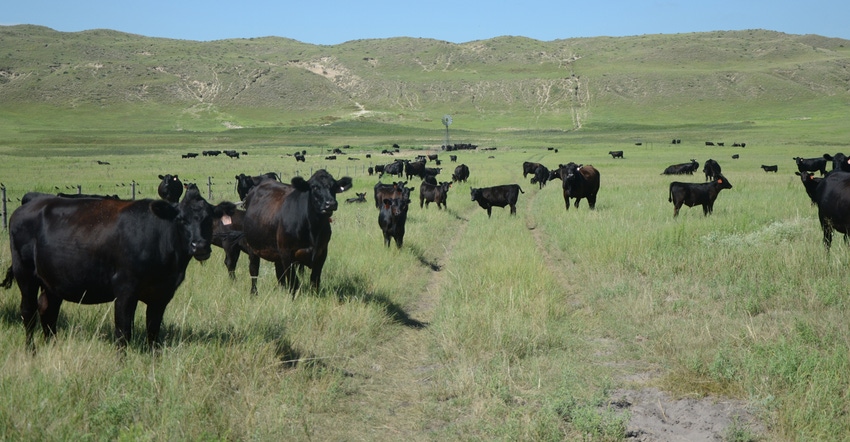
Most of the time, when nutrient runoff is discussed in agriculture, the focus is on best management practices on the crop production side.
However, as Martha Kauffman, managing director of the northern Great Plains region for the World Wildlife Fund, pointed out during the 2019 Daugherty Water for Food Conference, grasslands — specifically on the Great Plains — have a big role to play in reducing nutrient loads in the Missouri and Mississippi river basins.
It can be a contentious topic in the wake of flood events and with ongoing concerns of Missouri River infrastructure being managed more for wildlife habitat rather than for flood control.
So, with that in mind, it's important to point out that much of the northern Missouri River basin (which includes the northern Great Plains) still is in native prairie and doesn't contribute much to nitrogen runoff. And as Kauffman and others pointed out at the Water for Food Conference, it highlights the important role beef production and grazing play in the overall health of the ecosystem.
"What's holding this all together are the root systems of the prairie plants," she says. "In the northern Great Plains alone, there are over 1,500 different species of native plants that make up the diversity of life on the prairie both above ground and below ground."
Certain prairie grass roots can reach 10 to 15 feet or more in depth. For example, big bluestem has a rooting depth of 6 to 10 feet, compared with the average rooting depth of Kentucky bluegrass, about 3 to 4 inches.
While these grassland systems provide carbon storage, improved water infiltration, root mass and organic matter in the soil, Kauffman pointed out one of the biggest threats to these ecosystems is conversion to cropland.
"Grasslands globally are the least-protected, most-converted biome on the planet, particularly temperate grasslands,” she says. “Of which, the Great Plains of North America are the largest extent, and historically, the largest extent of temperate grasslands on the planet.
“There's really only four places with extensive temperate grasslands left — the Great Plains of North America, the Kazakh Steppe, Mongolia and Argentina. So, this is a unique and important area for a number of reasons. It's going away pretty fast. It's slowed down in the last few years, but on average since 2009, the rate of loss is exceeding the loss of rainforest in the Brazilian Amazon."
The World Wildlife Fund (WWF) has tracked the loss of native prairie for the past three years and released results in its annual Plowprint Report.
There are about 355 million acres of native prairie intact in the Great Plains — with about 127 million acres intact in the northern Great Plains, Kauffman says.
The 2018 Plowprint Report, which tracks the acres of native prairie converted in 2017, shows that about 1.7 million acres of native prairie were converted in 2017. This leaves about 53% of the Great Plains still intact, Kauffman says. However, in the northern Great Plains, about 70% of native grasslands are still intact, and the region lost about 540,000 acres of grassland in 2017.
Of course, on marginal ground, the percentage of remaining grassland is higher — about 87% for the Great Plains as a whole, and 70% for the northern Great Plains. Still, about 63 million acres were converted on marginal soils since 2009 in the Great Plains overall, and 15 million acres were lost in the northern Great Plains.
But what effect does this have on soil erosion, runoff and water quality?
WWF recently partnered with LimnoTech, an environmental engineer firm, to develop a Soil and Water Assessment Tool model to estimate the amount of water runoff, sediment runoff and phosphorus and nitrogen runoff from 1998 to 2013, based on two scenarios.
The first is a baseline scenario based on the current mix of crop and grassland. The second is a grassland conversion scenario — a "what if" scenario, where 25 million additional acres in the Missouri River basin are converted from grassland to cropland and crop management practices typical of the region are used.
The model factored in tillage and fertilizer practices and tile drainage, as well as topography, slope and soils data in specific regions of the Missouri River basin.
"We found that the surface runoff would increase by 26%, sediment would increase by 46%, phosphorus would increase by 41%, and nitrogen by 31%," Kauffman says.
The results of the 2017 study suggested preventing conversion of grassland to cropland could potentially prevent more than 1.7 trillion gallons of surface runoff, the loss of about 46 million tons of sediment, 87 million pounds of total phosphorus, and 427 million pounds of total nitrogen from the Missouri River basin area each year.
Of course, these numbers are estimates based on "best available data." And while this doesn't account for the loss of soil organic carbon or reduced risk of flooding because of increased infiltration, the take-home is the role of grasslands can't be overlooked in the water quality discussion.
About the Author(s)
You May Also Like






